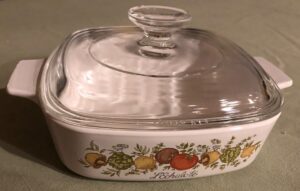
by Dr. Lori Verderame
CorningWare has been just one of the many kitchen collectibles that have been part of the design of kitchens for decades. More than 750 million pieces of CorningWare from its product lines have been manufactured since the early 1950s. Some vintage CorningWare products are casserole dishes, cake pans, dinner serving pieces, Dutch ovens, frying pans, bowls, coffee pots, browning skillets, loaf pans, percolators, pie plates, ramekins, sauce pans, souffle dishes, and teapots, to name a few.
What is CorningWare?

CorningWare ovenware was made of a material known as Pyroceram. Pyroceram is a ceramic-glass invention that was all the rage when it was discovered in a lab in upstate New York. Pyroceram was invented by Stanley Donald Stookey in the 1953. Stookey discovered Pyroceram, a white glass-ceramic material capable of withstanding a thermal shock or a sudden temperature change of 840 degrees F. The discovery happened for the scientist by accident while he was working with photosensitive glass.
Stookey placed a piece of white glass ceramic material into a furnace planning. He was going to heat it to 600 degrees. He checked the furnace and the temperature gauge was stuck at 900 degrees F and the piece in the furnace had turned a milky white color. Upon removing the piece from the furnace using tongs, the piece fell to the floor. Expecting it to break, the piece did not shatter. This was a major breakthrough. The material which came to be known as Pyroceram was later used in the ballistic missile program for heat resistant nose cones and was marketed widely as the ovenware that we now all know as CorningWare.
Who was Stanley Donald Stookey?
Stanley Donald Stookey (known as S. Donald Stookey) was born on May 23, 1915, in Hay Springs, Nebraska. He was raised with his family in Cedar Rapids, Iowa, and received a bachelor’s degree in chemistry and math in 1936 from Coe College in Cedar Rapids before earning a master’s degree from Lafayette College in Easton, Pennsylvania. He received his doctorate in physical chemistry from the Massachusetts Institute of Technology (MIT) in 1940.
He received two job offers after receiving his Ph.D. degree. One job offer was from Nabisco and the other was from Corning. He had never heard of the Corning glass company but he was not interested in baking bread according to his obituary so, he accepted the job at Corning in the firm’s Research and Development Division. His career included achieving 60 patents, the invention of Pyroceram or CorningWare as it is known, working at Corning for many decades until his retirement from Corning in 1987, the publication of his autobiography entitled “Explorations in Glass” in 2000, and being inducted into the National Inventors Hall of Fame in 2010.
Stookey’s invention of Pyroceram could be used from the oven to refrigerator or on stovetop or in the broiler. Pyroceram could withstand varying high temperatures. CorningWare is microwave and dishwasher safe according to its manufacturer, too.
What to Look For
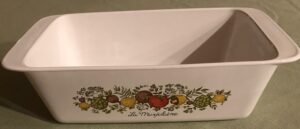
When it comes to vintage CorningWare pieces for collectors or for resale, consider collecting popular patterns and sets, rare types of pieces like percolator coffee pots, detachable handles (do not pass these up if you can find them) and variety of ovenware and dish forms like browning skillets, covered casserole dishes, or ramekins. These bring good money on the resale market with collectors.
Some CorningWare pieces are specifically not Pyroceram. These pieces are typically marked on the bottom as “Not for Stovetop Use”. That is one way to tell if you have a Pyroceram piece or not. Look for the marks on the underside which will indicate pattern name, production numbers, etc.
Remember that dish or ovenware lids or matching covers that were used on CorningWare patterns were manufactured of Pyrex. These pieces cannot be used in all oven or stovetop environments. Vintage pieces should be used for collectible display rather than oven use for long term retention.
Changes over the years took place in CorningWare’s very popular, collectible, and highly desirable Blue Cornflower ovenware pattern. For instance, the handles on covered casserole dishes were enlarged overtime and if you can find a piece of CorningWare’s Blue Cornflower pattern with small handles, grab it as it is older and worth more than their circa 1980s versions.
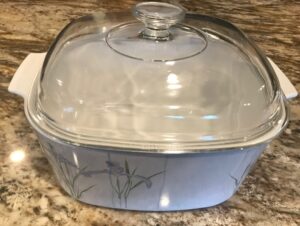
One thing that many collectors find surprising is that Corning no longer makes CorningWare. World Kitchen purchased CorningWare and Pyrex ending the period when CorningWare was made by Corning. CorningWare factories in Charleroi, PA and Clinton, IL were closed due to reduced interest in the traditional CorningWare ovenware lines. CorningWare’s production of Pyroceram stopped in 2000. A stoneware ceramic line of cookware was introduced in 2001. In 2008, CorningWare’s stovetop line of cookware was re-introduced by Corelle and manufactured in France by Keraglass. The French Keraglass factory is the only factory in the world to make the Pyroceram cookware based on Stookey’s invention, thus CorningWare was introduced to a new generation.
Valuable CorningWare Patterns
The collectibles market has revived an interest in vintage CorningWare pieces and has highlighted some of the manufacturer’s more popular patterns. While CorningWare produced many patterns, some are much more desirable and collectors compared to others. These are some of the most collectible and valuable patterns that are selling online in the range of $50 to $500 for one traditional covered casserole dish with cover.
Vintage CorningWare pieces, those pieces made before 1999, are in demand and are traded widely online. Why? The most common reason is that many young and seasoned collectors alike want to collect pieces that remind them of their grandmother’s and mother’s kitchens and what was found in them. Ovenware is one of the most emotionally charged collectibles as it brings back memories of family dinners and holiday gatherings with vintage ovenware.
The most common pattern is CorningWare’s Blue Cornflower pattern. vintage CorningWare patterns from the 1970s and 1980s in floral, vegetable, and period patterns are popular with collectors now. CorningWare patterns that experienced short production runs are rare to find online now. Some of the most popular patterns are Blue Cornflower which was the first pattern issued and one that is easy to find but still desirable with collectors, Wildflower and Floral Bouquet, both popular for their bright floral designs.
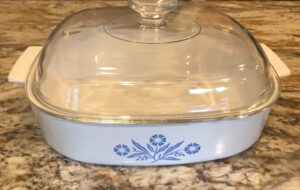
Blue Cornflower pattern (also referred to as Cornflower Blue), circa 1958-1988 – Designed by Joseph Baum, an artist at the Charles Brunelle Advertising Agency located in Hartford, Connecticut, the Blue Cornflower pattern became synonymous with the CorningWare company. Blue Cornflower CorningWare covered casserole dishes and other pieces are the first designs in the CorningWare arsenal of fantastic and flexible ovenware. Blue Cornflower pattern pieces was made in large numbers and was the quintessential CorningWare pattern. For more than three decades, the simple blue flowers on a white background were CorningWare trademark and quickly became a standard in American kitchens. This is the pattern that is most commonly purchased by collectors with its traditional vintage look based on the blue/white porcelains of Meissen, Cantonware, and Royal Copenhagen. It is the mid century modern American version of the traditional look of porcelain ceramic cookware and kitchenware.
Starburst pattern, circa late 1950s-early 1960s – The Starburst pattern is a typical pattern used in the late 1950s associated with the space race. CorningWare produced a blue/black and platinum Starburst pattern pieces that remain collectible today. This is one of the most desirable patterns of CorningWare.
Floral Bouquet pattern, circa 1971-1975 – The Flower Bouquet pattern features blue and yellow flower blooms. The floral patterns of CorningWare are always a good seller online, at estate sales, thrift stores, and yard sales.
Blue Heather pattern, circa mid 1970s -The Blue Heather design features small five-petal flower, like the Cornflower Blue pattern, also in blue with vines and leaves to accompany designs of delicate flowers. The similarity between the Blue Cornflower and Blue Heather patterns have helped to make the Blue Heather pattern sell for higher prices online.
Nature’s Bounty pattern, circa 1971 – The Nature’s Bounty Corningware pattern is mustard yellow with vegetables in the typical period colors of the early 1970s. Like most Corningware patterns, the serving dishes are a white ceramic ground and the vegetables remind collectors of the plentiful feast on Age of Aquarius dinner tables.
The Country Festival (also known as Friendship Bird) pattern, circa mid to late 1970s – The Country Festival pattern features two blue birds in profile facing each other. A tulip of orange and yellow—more typical 1970s era color schemes—are decorated between the two birds. Country style CorningWare has always been popular with collectors.
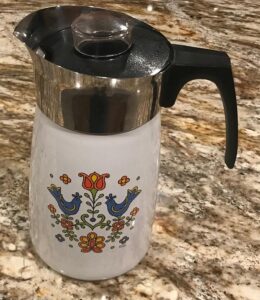
Spice O’ Life (also known as French Spice) pattern, circa 1972-1987 – The Spice O’Life pattern, like the Cornflower Blue pattern, is among CorningWare’s most produced and purchased ovenware line. The design of Spice O’Life patterned dishes are the typical 1970s era earth- toned colors with images of vegetables that included mushrooms, artichokes, and garlic. The titles L’Echalote, a type of shallot, and La Marjolaine, the herb marjoram, accompany images of market vegetables on the front of this pattern of CorningWare.

French White pattern, circa 1978-1990s – In addition to a CorningWare line of ovenware that was called the All White pattern and also known as the Just White pattern, circa mid to late 1960s, the French White pattern was all the rage with homemakers and chefs alike by the 1970s. If you were in an American kitchen during the 1970s or 1980s, you probably were consulting the recipes published in books by amazing chefs such as Paul Bocuse and Julia Child. As you read the pages voraciously, your ovenware of choice for your favorite French meal was probably the classic CorningWare French White line.
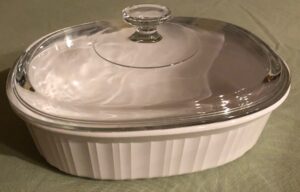
The French White pattern is a vintage CorningWare pattern that looks back to the tradition of French cooking using classic, white ovenware dishes. This is a timeless pattern and one which looks both classic and casual when used in service. Julia Child’s groundbreaking cookbook about French cooking certainly had an impact on how American amateur chefs select their favorite ovenware dishes.
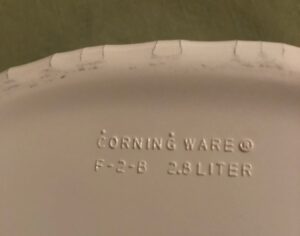
Wild Flower pattern, circa 1977-1984 – The Wild Flower pattern is true to its name as orange poppies flowers are the main attraction of this ovenware pattern. The wild flowers on these Corningware dishes are yellow, green, blue, and orange and were popular in the early years of the 1980s.
English Meadow pattern, circa 1980s-1990s – The English Meadow pattern shows the interest in all things British which was a cultural commonality during the 1980s when the world looked to Buckingham Palace for direction in all things high style. The English Meadow pattern from CorningWare highlighted the Royal Family and England’s well known gardening tradition. This Corningware ovenware features lovely designs with small vines of small yellow, blue, orange/red flowers that were popular with newlyweds and collectors alike.
Other vintage CorningWare patterns that intrigue collectors include Bliss, Blue Elegance, Cool Pansies, Country Rose, Dainty Flora, Dandy Blossoms, Elegant City, European Herbs, Herb Country, Lilyville, Lush, Petite Trio, Plum, Salad Seasons and Warm Pansies and others. Some rare patterns include CorningWare’s Black Starburst (percolator only), pattern produced from 1959-1963, the Blue Heather pattern produced from 1976-77 and the Butterscotch pattern produced in 1969 only. Other limited edition gift lines by CorningWare including Nature’s Bounty manufactured in 1971 only, Platinum Filigree produced from 1966 to 1968, and Renaissance produced in 1970 remain rare and sought after by collectors as well as some promotional pieces that were not sold in stores.
Watch videos on my YouTube channel where I show you how to identify vintage CorningWare. I can appraise your CorningWare pieces from photos or you can show me your pieces during a video call.


